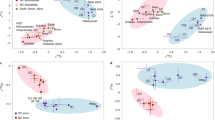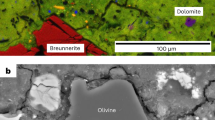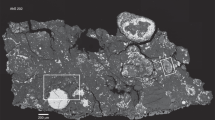Abstract
Recent dynamical models of Solar System evolution and isotope studies of rock-forming elements in meteorites have suggested that volatile-rich asteroids formed in the outer Solar System beyond Jupiter’s orbit, despite being currently located in the main asteroid belt1,2,3,4. The ambient temperature under which asteroids formed is a crucial diagnostic to pinpoint the original location of asteroids and is potentially determined by the abundance of volatiles they contain. In particular, abundances and 13C/12C ratios of carbonates in meteorites record the abundances of carbon-bearing volatile species in their parent asteroids. However, the sources of carbon for these carbonates remain poorly understood5,6,7,8. Here we show that the Tagish Lake meteorite contains abundant carbonates with consistently high 13C/12C ratios. The high abundance of 13C-rich carbonates in Tagish Lake excludes organic matter as their main carbon source5,9. Therefore, the Tagish Lake parent body, presumably a D-type asteroid10, must have accreted a large amount of 13C-rich CO2 ice. The estimated 13C/12C and CO2/H2O ratios of ice in Tagish Lake are similar to those of cometary ice11,12. Thus, we infer that at least some D-type asteroids formed in the cold outer Solar System and were subsequently transported into the inner Solar System owing to an orbital instability of the giant planets1,3.
This is a preview of subscription content, access via your institution
Access options
Access Nature and 54 other Nature Portfolio journals
Get Nature+, our best-value online-access subscription
$29.99 / 30 days
cancel any time
Subscribe to this journal
Receive 12 digital issues and online access to articles
$119.00 per year
only $9.92 per issue
Buy this article
- Purchase on Springer Link
- Instant access to full article PDF
Prices may be subject to local taxes which are calculated during checkout



Similar content being viewed by others
Data availability
The data that support the plots within this paper and other findings of this study are available from the corresponding author upon reasonable request.
References
Levison, H. F. et al. Contamination of the asteroid belt by primordial trans-Neptunian objects. Nature 460, 364–366 (2009).
Walsh, K. J., Morbidelli, A., Raymond, S. N., O’Brien, D. P. & Mandell, A. M. A low mass for Mars from Jupiter’s early gas-driven migration. Nature 475, 206–209 (2011).
Vokrouhlický, D., Bottke, W. F. & Nesvorný, D. Capture of trans-Neptunian planetesimals in the main asteroid belt. Astron. J. 152, 39 (2016).
Kruijer, T. S., Burkhardt, C., Budde, G. & Kleine, T. Age of Jupiter inferred from the distinct genetics and formation times of meteorites. Proc. Natl Acad. Sci. USA 114, 6712–6716 (2017).
Alexander, C. M. O.’D., Bowden, R., Fogel, M. L. & Howard, K. T. Carbonate abundances and isotopic compositions in chondrites. Meteorit. Planet. Sci. 50, 810–833 (2015).
Fujiya, W. et al. Comprehensive study of carbon and oxygen isotopic compositions, trace element abundances, and cathodoluminescence intensities of calcite in the Murchison CM chondrite. Geochim. Cosmochim. Acta 161, 101–117 (2015).
Vacher, L. G., Marrocchi, Y., Villeneuve, J., Verdier-Paoletti, M. J. & Gounelle, M. Petrographic and C & O isotopic characteristics of the earliest stages of aqueous alteration of CM chondrites. Geochim. Cosmochim. Acta 213, 271–290 (2017).
Vacher, L. G., Marrocchi, Y., Villeneuve, J., Verdier-Paoletti, M. J. & Gounelle, M. Collisional and alteration history of the CM parent body. Geochim. Cosmochim. Acta 239, 213–234 (2018).
Cody, G. D. & Alexander, C. M. O.’D. NMR studies of chemical structural variation of insoluble organic matter from different carbonaceous chondrite groups. Geochim. Cosmochim. Acta 69, 1085–1097 (2005).
Hiroi, T., Zolensky, M. E. & Pieters, C. M. The Tagish Lake meteorite: a possible sample from a D-type asteroid. Science 293, 2234–2236 (2001).
Ootsubo, T. AKARI near-infrared spectroscopic survey for CO2 in 18 comets. Astrophys. J. 752, 15 (2012).
Hässig, M. et al. Isotopic composition of CO2 in the coma of 67P/Churyumov–Gerasimenko measured with ROSINA/DFMS. Astron. Astrophys. 605, A50 (2017).
Brown, P. G. et al. The fall, recovery, orbit, and composition of the Tagish Lake meteorite: a new type of carbonaceous chondrite. Science 290, 320–325 (2000).
Zolensky, M. E. et al. Mineralogy of Tagish Lake: an ungrouped type 2 carbonaceous chondrite. Meteorit. Planet. Sci. 37, 737–761 (2002).
Mumma, M. J. & Charnley, S. B. The chemical composition of comets—emerging taxonomies and natal heritage. Annu. Rev. Astron. Astrophys. 49, 471–524 (2011).
Grady, M. M., Verchovsky, A. B., Franchi, I. A., Wright, I. P. & Pillinger, C. T. Light element geochemistry of the Tagish Lake CI2 chondrite: comparison with CI1 and CM2 meteorites. Meteorit. Planet. Sci. 37, 713–735 (2002).
Aponte, J. C., McLain, H. L., Dworkin, J. P. & Elsila, J. E. Aliphatic amines in Antarctic CR2, CM2, and CM1/2 carbonaceous chondrites. Geochim. Cosmochim. Acta 189, 296–311 (2016).
Alexander, C. M. O.’D. et al. The provenances of asteroids, and their contributions to the volatile inventories of the terrestrial planets. Science 337, 721–723 (2012).
Alexander, C. M. O.’D., Howard, K. T., Bowden, R. & Fogel, M. L. The classification of CM and CR chondrites using bulk H, C and N abundances and isotopic compositions. Geochim. Cosmochim. Acta 123, 244–260 (2013).
Burbine, T. H. in Treatise on Geochemistry, Vol. 2: Meteorites and Cosmochemical Processes 2nd edn (ed. Davis, A. M.) 365–414 (Elsevier, 2014).
Fayolle, E. C., Öberg, K. I., Cuppen, H. M., Visser, R. & Linnartz, H. Laboratory H2O:CO2 ice desorption data: entrapment dependencies and its parameterization with an extended three-phase model. Astron. Astrophys. 529, A74 (2011).
Marley, M. S., Fortney, J. J., Hubickyj, O., Bodenheimer, P. & Lissauer, J. J. On the luminosity of young Jupiters. Astrophys. J. 655, 541–549 (2007).
Okuzumi, S., Momose, M., Shirono, S., Kobayashi, H. & Tanaka, H. Sintering-induced dust ring formation in protoplanetary disks: application to the HL Taudisk. Astrophys. J. 821, 82 (2016).
DeMeo, F. E. & Carry, B. Solar System evolution from compositional mapping of the asteroid belt. Nature 505, 629–634 (2014).
Nakamura-Messenger, K., Messenger, S., Keller, L. P., Clemett, S. J. & Zolensky, M. E. Organic globules in the Tagish Lake meteorite: remnants of the protosolar disk. Science 314, 1439–1442 (2006).
Piani, L., Yurimoto, H. & Remusat, L. A dual origin for water in carbonaceous asteroids revealed by CM chondrites. Nat. Astron. 2, 317–323 (2018).
Hartogh, P. Ocean-like water in the Jupiter-family comet 103P/Hartley 2. Nature 478, 218–220 (2011).
Dauphas, N. The isotopic nature of the Earth’s accreting material through time. Nature 541, 521–524 (2017).
Marty, B. et al. Origins of volatile elements (H, C, N, noble gases) on Earth and Mars in light of recent results from the ROSETTA cometary mission. Earth Planet. Sci. Lett. 441, 91–102 (2016).
Marty, B. et al. Xenon isotopes in 67P/Churyumov–Gerasimenko show that comets contributed to Earth’s atmosphere. Science 356, 1069–1072 (2017).
Rubin, A. E., Trigo-Rodríguez, J. M., Huber, H. & Wasson, J. T. Progressive aqueous alteration of CM carbonaceous chondrites. Geochim. Cosmochim. Acta 71, 2361–2382 (2007).
Johnson, C. A. & Prinz, M. Carbonate compositions in CM and CI chondrites, and implications for aqueous alteration. Geochim. Cosmochim. Acta 57, 2843–2852 (1993).
Riciputi, L. R., McSween, H. Y. Jr, Johnson, C. A. & Prinz, M. Minor and trace element concentrations in carbonates of carbonaceous chondrites, and implications for the compositions of coexisting fluids. Geochim. Cosmochim. Acta 58, 1343–1351 (1994).
de Leuw, S., Rubin, A. E. & Wasson, J. T. Carbonates in CM chondrites: complex formational histories and comparison to carbonates in CI chondrites. Meteorit. Planet. Sci. 45, 513–530 (2010).
Lee, M. R., Lindgren, P. & Sofe, M. R. Aragonite, breunnerite, calcite and dolomite in the CM carbonaceous chondrites: high fidelity recorders of progressive parent body aqueous alteration. Geochim. Cosmochim. Acta 144, 126–156 (2014).
Tyra, M. A., Farquhar, J., Guan, Y. & Leshin, L. A. An oxygen isotope dichotomy in CM2 chondritic carbonates—a SIMS approach. Geochim. Cosmochim. Acta 77, 383–395 (2012).
Lee, M. R., Sofe, M. R., Lindgren, P., Starkey, N. A. & Franchi, I. A. The oxygen isotope evolution of parent body aqueous solutions as recorded by multiple carbonate generations in the Lonewolf Nunataks 94101 CM2 carbonaceous chondrite. Geochim. Cosmochim. Acta 121, 452–466 (2013).
Lindgren, P., Lee, M. R., Starkey, N. A. & Franchi, I. A. Fluid evolution in CM carbonaceous chondrites tracked through the oxygen isotopic compositions of carbonates. Geochim. Cosmochim. Acta 204, 240–251 (2017).
Izawa, M. R. M. et al. Variability, absorption features, and parent body searches in “spectrally featureless” meteorite reflectance spectra: case study—Tagish Lake. Icarus 254, 324–332 (2015).
Nakamura, T., Noguchi, T., Zolensky, M. E. & Tanaka, M. Mineralogy and noble-gas signatures of the carbonate-rich lithology of the Tagish Lake carbonaceous chondrite: evidence for an accretionary breccia. Earth Planet. Sci. Lett. 207, 83–101 (2003).
Brown, P. G., Revelle, D. O., Tagliaferri, E. & Hildebrand, A. R. An entry model for the Tagish Lake fireball using seismic, satellite and infrasound records. Meteorit. Planet. Sci. 37, 661–675 (2002).
Kozdon, R., Ushikubo, T., Kita, N. T., Spicuzza, M. & Valley, J. W. Intratest oxygen isotope variability in the planktonic foraminifer N. pachyderma: real vs. apparent vital effects by ion microprobe. Chem. Geol. 258, 327–337 (2009).
Kita, N. T., Ushikubo, T., Fu, B. & Valley, J. W. High precision SIMS oxygen isotope analysis and the effect of sample topography. Chem. Geol. 264, 43–57 (2009).
Tenner, T. J., Ushikubo, T., Kurahashi, E., Kita, N. T. & Nagahara, H. Oxygen isotope systematics of chondrule phenocrysts from the CO3.0 chondrite Yamato 81020: evidence for two distinct oxygen isotope reservoirs. Geochim. Cosmochim. Acta 102, 226–245 (2013).
Fujiya, W., Fukuda, K., Koike, M., Ishida, A. & Sano, Y. Oxygen and carbon isotopic ratios of carbonates in the Nogoya CM chondrite. In Proc. 47th Lunar and Planetary Science Conference 1712 (Lunar and Platenary Institute, 2016).
Shirai, K. et al. Minor and trace element incorporation into branching coral Acropora nobilis skeleton. Geochim. Cosmochim. Acta 72, 5386–5400 (2008).
Chan, Q. H. S., Zolensky, M. E., Bodnar, R. J., Farley, C. & Cheung, J. C. H. Investigation of organo-carbonate associations in carbonaceous chondrites by Raman spectroscopy. Geochim. Cosmochim. Acta 201, 392–409 (2017).
Benedix, G. K., Leshin, L. A., Farquhar, J., Jackson, T. & Thiemens, M. H. Carbonates in CM2 chondrites: constraints on alteration conditions from oxygen isotopic compositions and petrographic observations. Geochim. Cosmochim. Acta 67, 1577–1588 (2003).
Jenniskens, P. et al. Radar-enabled recovery of the Sutter’s Mill meteorite, a carbonaceous chondrite regolith breccia. Science 338, 1583–1587 (2012).
Vacher, L. G., Marrocchi, Y., Verdier-Paoletti, M. J., Villeneuve, J. & Gounelle, M. Inward radial mixing of interstellar water ices in the solar protoplanetary disk. Astrophys. J. 827, L1 (2016).
Verdier-Paoletti, M. J. et al. Oxygen isotope constraints on the alteration temperatures of CM chondrites. Earth Planet. Sci. Lett. 458, 273–1281 (2017).
Tyra, M., Brearley, A. & Guan, Y. Episodic carbonate precipitation in the CM chondrite ALH 84049: an ion microprobe analysis of O and C isotopes. Geochim. Cosmochim. Acta 175, 195–207 (2016).
Fujiya, W. Oxygen isotopic ratios of primordial water in carbonaceous chondrites. Earth Planet. Sci. Lett. 481, 264–272 (2018).
Clayton, R. N. & Mayeda, T. K. The oxygen isotope record in Murchison and other carbonaceous chondrites. Earth Planet. Sci. Lett. 67, 151–161 (1984).
Alexander, C. M. O.’D., Fogel, M., Yabuta, H. & Cody, G. D. The origin and evolution of chondrites recorded in the elemental and isotopic compositions of their macromolecular organic matter. Geochim. Cosmochim. Acta 71, 4380–4403 (2007).
Herd, C. D. K. et al. Origin and evolution of prebiotic organic matter as inferred from the Tagish Lake meteorites. Science 332, 1304–1307 (2011).
Yuen, G., Blair, N., Des Marais, D. J. & Chang, S. Carbon isotope composition of low molecular weight hydrocarbons and monocarboxylic acids from Murchison meteorite. Nature 307, 252–254 (1984).
Sephton, M. A. & Gilmour, I. Compound-specific isotope analysis of the organic constituents in carbonaceous chondrites. Mass Spectrom. Rev. 20, 111–120 (2001).
Acknowledgements
We thank N. Takahata, T. Kagoshima, A. Ishida and E. Gröner for assistance with the ion probe analyses. This work was supported by JSPS KAKENHI grant numbers 16K17838, 17K18814 and 18H04454, and UK Science and Technology Facilities Council grant ST/N000846/1.
Author information
Authors and Affiliations
Contributions
W.F. designed this work, W.F., P.H., T.U., K.F., M.K. and Y.S. performed the ion probe analyses, P.L. and M.R.L. carried out the petrologic and mineralogical observations of the samples, K.S. prepared the standard materials for the ion probe analyses, and all authors participated in discussion and preparation of the manuscript.
Corresponding author
Ethics declarations
Competing interests
The authors declare no competing interests.
Additional information
Peer review information: Nature Astronomy thanks Laurette Piani and the other, anonymous, reviewer(s) for their contribution to the peer review of this work.
Publisher’s note: Springer Nature remains neutral with regard to jurisdictional claims in published maps and institutional affiliations.
Rights and permissions
About this article
Cite this article
Fujiya, W., Hoppe, P., Ushikubo, T. et al. Migration of D-type asteroids from the outer Solar System inferred from carbonate in meteorites. Nat Astron 3, 910–915 (2019). https://doi.org/10.1038/s41550-019-0801-4
Received:
Accepted:
Published:
Issue Date:
DOI: https://doi.org/10.1038/s41550-019-0801-4
This article is cited by
-
Insights into the formation and evolution of extraterrestrial amino acids from the asteroid Ryugu
Nature Communications (2023)
-
A Comparison of Presolar Isotopic Signatures in Laboratory-Studied Primitive Solar System Materials and Comet 67P/Churyumov-Gerasimenko: New Insights from Light Elements, Halogens, and Noble Gases
Space Science Reviews (2023)
-
Early fluid activity on Ryugu inferred by isotopic analyses of carbonates and magnetite
Nature Astronomy (2023)
-
Constraints on Solar System early evolution by MicrOmega analysis of Ryugu carbonates
Nature Astronomy (2023)
-
Salts and organics on Ganymede’s surface observed by the JIRAM spectrometer onboard Juno
Nature Astronomy (2023)



